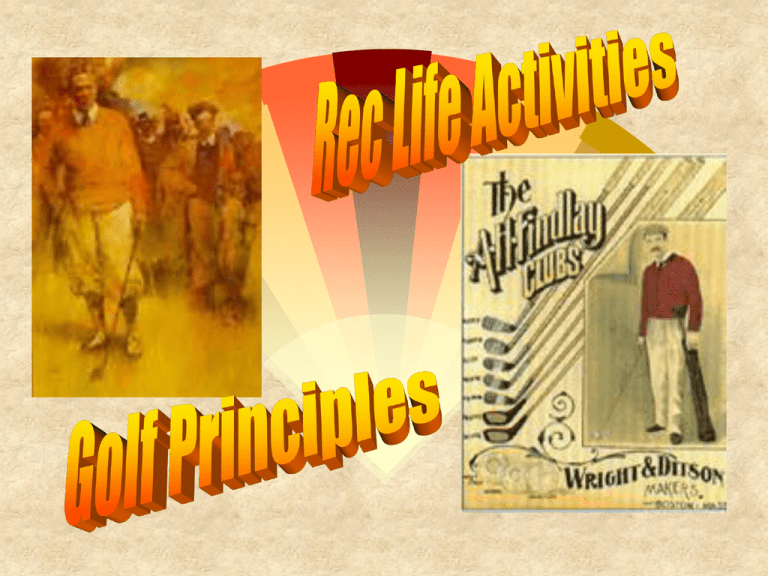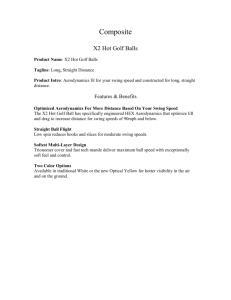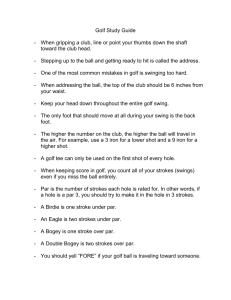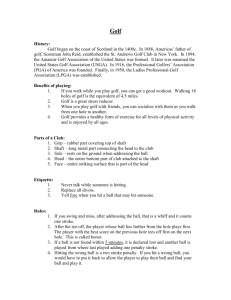Proper Ball Position
advertisement

Your grip is the only connection you have to the golf club. It is imperative that your hands match-up on the grip so that you can produce the straightest and most accurate shot. To do this you want to find your most natural position of your hands in relationship to your arms. This position of the hands is a relaxed position. Far too often people tense up their arms and are not able to relax and get that natural hand position. Let your arms hang, relaxed. They will do so in a natural position. For most of you it will look like this picture. Just let it hang naturally. Www.thegolfchannel.com Then place it onto the grip and then do the same with you're right hand. Let it hang in a relaxed position, not tense but relaxed. Place the right hand on in that position. Once you have those hands matched up and working as a team then you're able to deliver much more consistent shots on the golf course. Another key to a good grip is grip pressure. You want to hold on hard enough to not lose control of the club but not so hard that you lose any sort of swinging movement. The harder you hold on, your veins will begin showing and you've added tension to the golf swing. This won't result in very solid shots. A nice soft relaxed position of hands and grip pressure will lead to good consistent straight golf shots. Www.thegolfchannel.com The Left Hand The left hand is essential. You don't want to put the club too high in the palm of your hand. You want to position it diagonally across the palm. The Right Hand You should have a fairly neutral grip. ..don't hold too tightly. Put your right hand on the club, and align your thumbs, so that both thumbs are pointed down the club shaft. You will create a “V” shape between your thumb and your first finger, try to align the “V” so that it points to your left shoulder.. Www.thegolfchannel.com Linking Hands Together The hands need to stay together...this is vital. If you place a quarter on top of your left thumb and then close your right hand down, you can practice keeping a tight grip on the club. Grip Thickness You should make sure that your grips fit your hand properly. To check your grip, place your hand around the club. You don't want your middle fingers running into and overlapping the palm. You do want a small gap between the pinkie and pad on the hand. Www.thegolfchannel.com Posture is the foundation to your ability to strike the golf ball on a consistent basis. You want to find the posture that is going to put you into the best position to give you the best shaped golf swing to strike the ball on a consistent basis. That setup is simply an athletic ready to move position. Feet flat on the ground, feet barely shoulder width apart, tilting from your hips, knees slightly bent and back flat. Your weight is on the balls of your feet. We never want to get back on the heels for it's not a good balanced position. Www.thegolfchannel.com Your spine angle should be straight. If you take your golf club and put it down your back from the top of your head, down your neck and your entire spine. This should be a straight line. If you start to sit then your going to end up getting in to a much poorer position and your ability to get the ball airborn with directional control is definitely going to decrease. So a nice straight back, tilting forward, athletic and ready. This posture is going to produce your most accurate, consistent and best golf shots. Www.thegolfchannel.com The set-up is the only part of the golf swing we have total control over. The first step, which is many times overlooked, is to put your hands correctly on the club. The second thing you do, is to get your body in a position where you are in perfect balance. From here we can learn how to make a good swing. Getting those positions right is something you can practice without a golf ball. Www.thegolfchannel.com Another aspect of the set-up is ball position. Correct ball position in your stance has a tremendous amount to do with how well you strike the ball, and where it is going to go. Ball position changes a little bit for each club, but there is a good rule of thumb to follow, that will keep you in the right direction. First, everyone should start with your feet together and the ball positioned in the center. Www.thegolfchannel.com Next, move your left foot, a little to the left. Then move your right foot, a little bit more to the right. This will really help you to determine your proper ball position. With an iron; you want to keep the ball position just slightly forward of the middle of your stance. With your driver, you want to play the ball just inside your left heel, and widen your stance a little more than shoulder width. You could have a great swing, but if you are not lined up with your target properly, you may never hit the ball where you want it to go. So it is very important that we develop a reliable, good way of lining up with your target, every time. A very good habit to get into (and all of the pros I know do this) is to lie a golf club down on the ground in front of you, so that it is parallel to where you want the ball to go. The first step is to aim your club face at the desired target. Then you must get your body parallel with that same target line. As you can see; the club (red line) is going toward the target...and we can also see that the feet, knees, hips, shoulders and eyes are all along the target line as well... ...another good way to think about alignment is by imagining that your body is following along both rails of a train track. Practice with these good habits and you will hit many more of your shots on target. If you are doing very well, then you will notice that your divot will also follow down the target line. Www.thegolfchannel.com The Umbrella Stick an umbrella into the ground parallel to your legs. Make sure the umbrella is slanted slightly in towards you. As you start your backswing, you want to feel a slight bump, but not a sway. This gives you the ability to get your right hip in balance so you can turn your weight around your right hip. Quiet Motion For right handers, you want a very quiet left foot and left knee. You don't want a lot movement to start with. A Good Excercise Grab your shoulder and push it down and back and across. This gives you the winding effect that you want. Make sure the knuckles are down. Www.thegolfchannel.com It is important to have a straight left arm at impact, but not throughout the entire swing. If you try to keep your left arm too straight during the backswing, you are unable to hinge your wrist and you add unwanted tension to your swing. The important thing is to maintain a consistent distance, or width, from the butt end of the club and the center of your chest. Here is an example of how you can maintain your swing width at the top of the backswing. The width is the same as it was at address, except notice that the left arm shows a little bit of flex. Www.thegolfchannel.com Much of the power in your swing comes from all of your body parts working in unison. The shoulders and hips, especially, should turn together. What happens when we try to make a big turn is that the shoulders and hips will turn too soon. We have already made a full body turn, but the arms are still in the middle of the backswing. That means that the arms then need to catch up by moving independently. This breaks up the synchronicity and tempo of the swing. Www.thegolfchannel.com Here is one way to achieve good power without taking a big turn. First, concentrate on keeping your left foot flat on the ground throughout the swing. As you turn away, make sure that you rotate your shoulders only about 90 degrees. …while turning your hips only about 45 degrees. Notice how the left foot is still planted solidly on the ground and not raised up. Your backswing might feel and, in fact, be a little bit shorter. However, this will help you coil, thus creating more torque. Www.thegolfchannel.com There are a couple of problems with the old axiom that states that you should always finish as high as possible. First of all, there is a good chance that you may hurt your back. And second, mechanically, finishing high can cause you to rise up out of your spine angle too early. When you try to finish high, often times, your arms will look like this in your follow through. The result is loss of club head speed and you are basically pushing the ball down the fairway. What you want to do is make sure that your wrists re-hinge after impact. This takes pressure off of your back and increases your club head speed, which has a direct affect on overall distance. Www.thegolfchannel.com Www.thegolfchannel.com Water hazard----------- Augusta National No. 11: White Dogwood Cornus florida Par 4, 455 Yards The first of the water holes. Most golfers play their second shot to the right for the edge of the green or beyond trusting to a long putt or a chip shot to get close enough for par Augusta National No. 6: Juniper Juniperus virigniana Par 3, 180 Yards An elevated tee looks down on this hole with a giant hump at the right of the green. The pin position at the top of the hump is one of the most difficult on the course. -------Greenside Bunker Augusta National No. 16: Red Cercis canadensis Bud Par 3, 170 Yards The fairway is all water. The green has a little neck at the back of the green that sticks out to the left into the water. When the pin is there, it takes a desparate golfer to shoot for it. 5 wood 3 wood Driver Ace Putting the ball in the hole in one stroke. A hole in one. Address The position taken by the golfer over the ball in preparation to swing. Break The way the ball travels on the ground, bouncing or rolling. Also is a reference to the slope of the green. Bunker Also known as a "sand trap" -- a sand filled valley on the green. Considered a Hazard. Chip a short, low altitude shot taken on or near the green. Divot A piece of the grass taken up by the club on the stroke. Should be replaced after swing. Dogleg A left or right turn in the fairway that is usually a blind turn. Drive the longest distance stroke in golf. Shot from the tee box. Driver A wooden club used to get the maximum distance out of a shot. Fairway the area between the tee and the green on a golf course. Green The area nearest the hole were the grass is cut the shortest. Hazard An obstacle on the course such as water, the rough, or a sand trap . Iron A club made of iron or steel. Irons are of different sizes and thickness to get varying degrees of loft on the ball. Line The path the ball takes, whether on the green or the fairway. Mulligan A shot taken if the first one is missed. Not allowed in the rules of golf. Par The number of strokes that a player should take to complete the hole. Pitching a short shot pulling the ball into the air in a sharp arc. Putt hitting the ball on the green so that it rolls into the hole. Putter A short club with a flat face designed to roll the ball along the ground when hit. Range a place on the course to practice driving and putting. Rough Area of the course that has long grass alongside the fairways. Considered a hazard. Stroke swinging at the ball in an attempt to hit it. Each stroke counts when keeping score. Tee A small wooden stand that the ball is placed on. The ball is driven off the tee in the first drive of the hole being played. Every other stroke is played where the ball lies. Tee Box A flat area on the course usually marked with stakes where the initial drive or longest shot is made. Wedge a club used in giving the ball loft. Wood Clubs made of wood. They are made in varying sizes and thicknesses for different ways of hitting the ball. Terms of Usage Copyright©1999 learnFREE, Inc.








